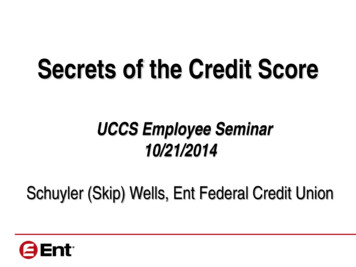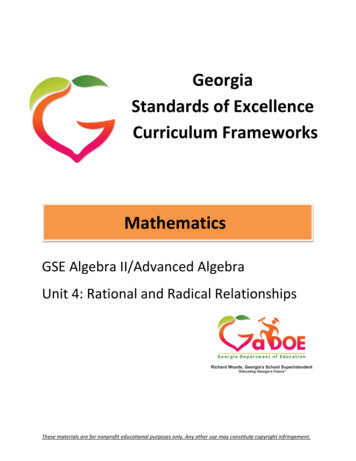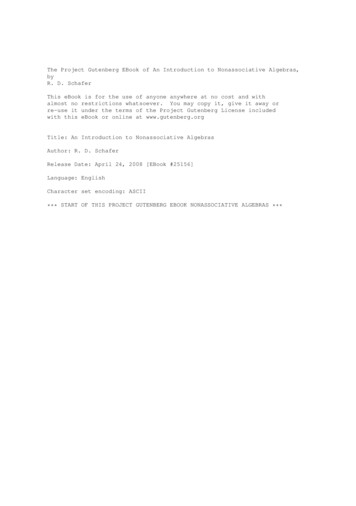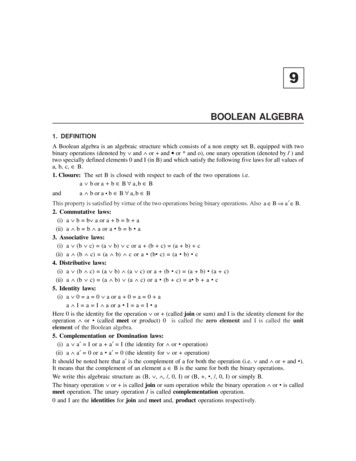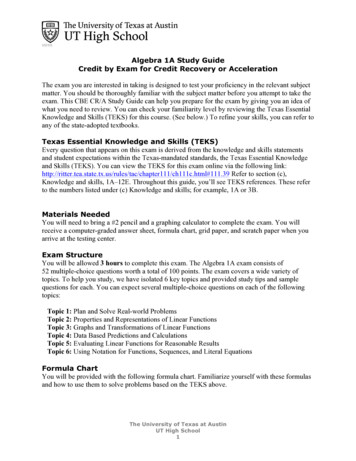
Transcription
102315Algebra 1A Study GuideCredit by Exam for Credit Recovery or AccelerationThe exam you are interested in taking is designed to test your proficiency in the relevant subjectmatter. You should be thoroughly familiar with the subject matter before you attempt to take theexam. This CBE CR/A Study Guide can help you prepare for the exam by giving you an idea ofwhat you need to review. You can check your familiarity level by reviewing the Texas EssentialKnowledge and Skills (TEKS) for this course. (See below.) To refine your skills, you can refer toany of the state-adopted textbooks.Texas Essential Knowledge and Skills (TEKS)Every question that appears on this exam is derived from the knowledge and skills statementsand student expectations within the Texas-mandated standards, the Texas Essential Knowledgeand Skills (TEKS). You can view the TEKS for this exam online via the following er111/ch111c.html#111.39 Refer to section (c),Knowledge and skills, 1A–12E. Throughout this guide, you’ll see TEKS references. These referto the numbers listed under (c) Knowledge and skills; for example, 1A or 3B.Materials NeededYou will need to bring a #2 pencil and a graphing calculator to complete the exam. You willreceive a computer-graded answer sheet, formula chart, grid paper, and scratch paper when youarrive at the testing center.Exam StructureYou will be allowed 3 hours to complete this exam. The Algebra 1A exam consists of52 multiple-choice questions worth a total of 100 points. The exam covers a wide variety oftopics. To help you study, we have isolated 6 key topics and provided study tips and samplequestions for each. You can expect several multiple-choice questions on each of the followingtopics:Topic 1: Plan and Solve Real-world ProblemsTopic 2: Properties and Representations of Linear FunctionsTopic 3: Graphs and Transformations of Linear FunctionsTopic 4: Data Based Predictions and CalculationsTopic 5: Evaluating Linear Functions for Reasonable ResultsTopic 6: Using Notation for Functions, Sequences, and Literal EquationsFormula ChartYou will be provided with the following formula chart. Familiarize yourself with these formulasand how to use them to solve problems based on the TEKS above.The University of Texas at AustinUT High School1
ALG 1A 35531 & 45531CBE CR/AStudy GuideThe University of Texas at AustinUT High School2
ALG 1A 35531 & 45531CBE CR/AStudy GuideScholastic HonestyWhen you arrive at the testing center you will be asked to carefully read the exam rules and signa statement agreeing to take the exam in accordance with the rules. This is called the Examinee’sCertification. The following is a copy of these rules:Examinee’s CertificationThis certification must be signed before the exam is administered and then returned withthe completed examination attached, or credit for the exam will not be given.Scholastic dishonesty is a serious academic violation that will not be tolerated. Scholasticdishonesty encompasses, but is not limited to: copying from another student’s work; using an unauthorized testing proctor or taking the exam at an unauthorized testinglocation; using materials not authorized by a testing proctor; possessing materials that are not authorized by a testing proctor, such as lessons, books, ornotes; knowingly using or soliciting, in whole or Topic, the contents of an unadministered test; collaborating with or seeking aid from another student without authorization during thetest; substituting for another person, or permitting another person to substitute for oneself, intaking a course test or completing any course-related assignment; using, buying, stealing, or transporting some or all of the contents of an unadministeredtest, test rubric, homework answer, or computer program.Evidence of scholastic dishonesty will result in a grade of F on the examination and an F inthe course (if applicable).At the testing center, you will be asked to sign a statement that saysyou have read the above and agree to complete the examination with scholastic honesty.The University of Texas at AustinUT High School3
ALG 1A 35531 & 45531CBE CR/AStudy GuideGeneral Study TipsThe bulleted lists and sample questions in this study guide can assist you in preparing for theexam. It is a fairly complete guide for studying, but does not cover every item on the test.Ultimately, you should use the TEKS to guide your exam preparation.Additional Study TipsThe following information provides direction for your studies. For each part, you will find studytips and sample questions to give you a general idea of the types of questions you can expect tosee on the exam.Topic 1: Plan and Solve Real-world ProblemsThis is a broad topic that can relate to any type of question. Students should show the ability tocreate a plan for problem-solving, explain their reasoning, and solve problems arising ineveryday life.Study Tips for Topic 1:This topic relates to TEKS 1A–1G. Familiarize yourself with those TEKS, and then be preparedto demonstrate knowledge of the following topics: Solve word problems about the workplace and every day interactions in society Justify your solution to a problem Explain if a solution is or is not reasonable Create and use tables, graphs, number lines, Venn Diagrams and other representations toorganize informationSample Questions for Topic 1:The following are sample questions. You can find the correct answers listed after the questions,but try answering the questions without looking at the answers first to check yourcomprehension.DIRECTIONS: Select the BEST responses to the following questions.1. Jose wants to make 3 dozen cupcakes for his friend’s Halloween party. The recipe makes½ dozen cupcakes and calls for ¾ cups of sugar. Jose will need to determine whether ornot he has enough sugar in his pantry before he begins.Which of the following illustrates a reasonable strategy Jose could use to estimate theamount of sugar he’ll need to make 3 dozen cupcakes?A. He will need to make 3 times the recipe, therefore he will need less than 3 cups ofsugar.B. He will need to make 6 times the recipe, therefore he will need more than 6 cups ofsugar.C. He can make an over-estimate by rounding ¾ cup up to 1 cup, multiplying by 2, andthen multiplying again by 3. He will need less than 6 cups of sugar.D. He can make an underestimate by rounding ¾ cup down to ½ cup, multiplying by 2and lastly multiplying again by 3. He will need less than 3 cups of sugar.The University of Texas at AustinUT High School4
ALG 1A 35531 & 45531CBE CR/AStudy GuideTopic 2: Properties and Representations of Linear FunctionsThis topic relates to your understanding of linear equations and their properties such as slope,parallel and perpendicular lines, domain, and range.Study Tips for Topic 2:This topic relates to TEKS 2A–2H. Familiarize yourself with those TEKS, and then be preparedto demonstrate knowledge of the following topics: Determine domain and range of linear functions when given equations and wordproblems Decide if the domain and range includes all real numbers or a certain subset of realnumbers such as integers only Write linear equations in slope intercept, standard, and point slope forms when given agraph, a table of values or a verbal description Write equations and solve problems involving direct variation Write equations of lines that are given as parallel or as perpendicular to given linesSample Questions for Topic 2:The following are sample questions. You can find the correct answers listed after the questions,but try answering the questions without looking at the answers first to check yourcomprehension.DIRECTIONS: Select the BEST responses to the following questions.2. Which of these is the equation of a line that is parallel to y 5x – 4 and goes through thepoint (–3, 1)?A. y 5x – 11y x 45B.18y x 55C.D. y 5x 163. A banquet hall sets up tables and chairs for weddings and parties throughout the year. Nomatter what type of party, they always set up 6 chairs at each table. A function is createdthat determines the total number of chairs, c, needed if exactly t tables are used. Which ofthese could represent the range of this function?A.B.C.D.All real numbersc 0c 6c {6, 12, 18, 24, }The University of Texas at AustinUT High School5
ALG 1A 35531 & 45531CBE CR/AStudy GuideTopic 3: Graphs and Transformations of Linear FunctionsThis topic relates to your understanding of graphing linear functions and how to expresstransformations such as reflections, stretches, and translations.Study Tips for Topic 3:This topic relates to TEKS 3A–3G. Familiarize yourself with those TEKS, and then be preparedto demonstrate knowledge of the following topics: Determine the slope when you are given a table of values Determine the rate of change in the context of a real world problem Graph linear functions and identify key features such as x-intercept and y-intercept Graph and shade the solution set of a 2-variable linear inequality Describe the effects of transforming the parent function y x and write the equations asy a(bx – c) d with specific values for a, b, c, and dSample Questions for Topic 3:The following are sample questions. You can find the correct answers listed after the questions,but try answering the questions without looking at the answers first to check yourcomprehension.DIRECTIONS: Select the BEST responses to the following questions.4. The solution set to which inequality is shown in the graph below?A. x – 2y 6B. x 2y 61C. y x 321D. y x 32The University of Texas at AustinUT High School6
ALG 1A 35531 & 45531CBE CR/AStudy Guide5. Which of these most accurately describes the slope of the graph below?A.B.C.D. 2 per day 50 per day 250 per day 1 per 2 daysTopic 4: Data Based Predictions and CalculationsThis topic relates to your understanding of creating linear functions to best fit data given from areal world problem and using that function to make reasonable predictions.Study Tips for Topic 4:This topic relates to TEKS 4A–4C. Familiarize yourself with those TEKS, and then be preparedto demonstrate knowledge of the following topics: Describe whether data has a positive or negative correlation and whether that correlationis strong or weak Use a graphing calculator to calculate the correlation coefficient between two sets of data Use linear regression to find the line of best fit for data and use that equation to makeaccurate predictions Describe the difference between correlation and causation in a real world contextThe University of Texas at AustinUT High School7
ALG 1A 35531 & 45531CBE CR/AStudy GuideSample Questions for Topic 4:The following are sample questions. You can find the correct answers listed after the questions,but try answering the questions without looking at the answers first to check yourcomprehension.DIRECTIONS: Select the BEST responses to the following questions.6. The table below represents a lawyer’s salary in each year after graduation. Using linearregression, calculate the correlation coefficient and predict the salary after 10 years.A.B.C.D.r 0.900; y 9,560r 0.999; y 95,660r 0.900; y 95,660r 0.999; y 90,5607. Which of the following statements illustrates correlation but not causation?A.B.C.D.Plants exposed to more sunlight grow faster.A student spends more time playing video games and less time sleeping.A soccer team’s goals per game increase as their practice time increases.In a particular town traffic accidents increase as sales of umbrellas increase.Topic 5: Evaluating Linear Functions for Reasonable ResultsThis topic relates to your understanding of solving linear equations and inequalities. You areexpected to understand how to check a solution and explain why it is reasonable or unreasonable.Study Tips for Topic 5:This topic relates to TEKS 5A and 5B. Familiarize yourself with those TEKS, and then beprepared to demonstrate knowledge of the following topics: Solve equations and inequalities with variables on both sides of the equation Solve equations and inequalities using the distributive propertyThe University of Texas at AustinUT High School8
ALG 1A 35531 & 45531CBE CR/AStudy GuideSample Questions for Topic 5:The following are sample questions. You can find the correct answers listed after the questions,but try answering the questions without looking at the answers first to check yourcomprehension.DIRECTIONS: Select the BEST responses to the following questions.8. Solve the following equation.–3(x 5) – 2x 3x 11A. 121B. 213C. 413 4D.Topic 6: Using Notation for Functions, Sequences, and LiteralEquationsThis topic relates to your understanding of solving linear equations and inequalities. You areexpected to understand how to check a solution and explain why it is reasonable or unreasonable.Study Tips for Topic 6:This topic relates to TEKS 12A–12E. Familiarize yourself with those TEKS, and then beprepared to demonstrate knowledge of the following topics: Recognize relations shown as a table, a graph, an equation, or a mapping diagram Determine whether or not a given relation meets the definition of a function Evaluate a function using function notation such as “f (x)” when given a domain value Identify terms of arithmetic and geometric sequences given in recursive function notationsuch as f (n) –3·f (n – 1) Create and use formulas for the n th term of an arithmetic or geometric sequence whengiven several terms Solve a given formula for a specific variable, such as F m ·aThe University of Texas at AustinUT High School9
ALG 1A 35531 & 45531CBE CR/AStudy GuideSample Questions for Topic 6:The following are sample questions. You can find the correct answers listed after the questions,but try answering the questions without looking at the answers first to check yourcomprehension.DIRECTIONS: Select the BEST responses to the following questions.9. Given that f ( x) A.B.C.D.7 8 x 2 , evaluate f .8 7 –2–10110. A sequence can be written as a function such that each term is defined in relation to the2term before it. For example, f (n) f (n 1) . If the first term is defined as f (1) 25,5find the 5th term of the sequence.A. 1016B. 2532C. 312532D. 125The University of Texas at AustinUT High School10
ALG 1A 35531 & 45531CBE CR/AStudy GuideAnswer KeyItem NumberCorrect Answer12345678910BDDBBDDDBBTEKSexpectation1A, 1B, 1D2E2A3D3A4A, 4C4B5A12B12CThe University of Texas at AustinUT High School11
1 Algebra 1A Study Guide Credit by Exam for Credit Recovery or Acceleration The exam you are interested in taking is designed to test your proficiency in the relevant subject matter. You should be thoroughly familiar with the subject matter before you attempt to take the exam. This CBE CR/A Study Guide can help you prepare for the exam by .


